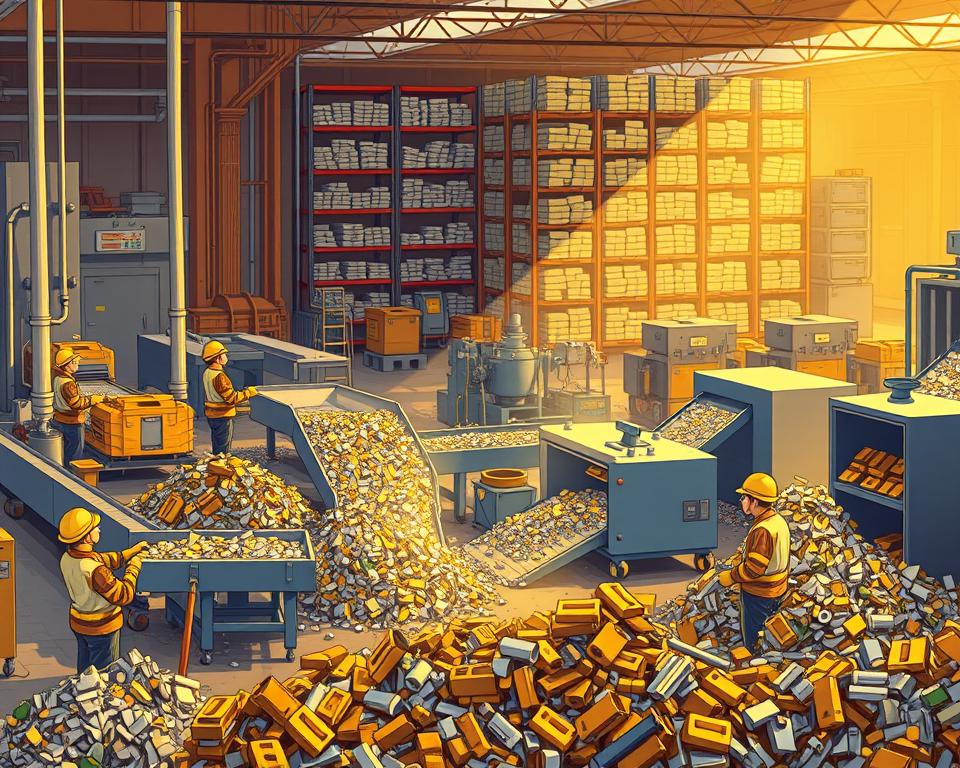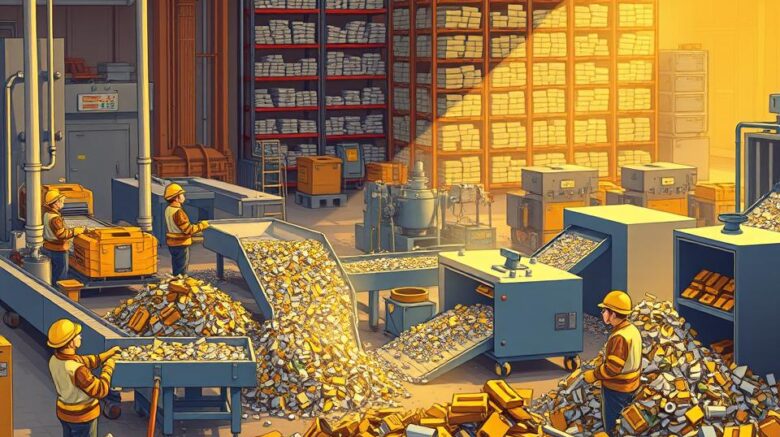Sustainable Strategies for Precious Metal Recovery
Were you aware that electronic waste throws away over $60 billion of precious metals annually? That eye-opening statistic shows how important recycling these metals really is. Recycling these metals benefits both the economy and the planet. Reclaiming gold, silver, platinum, and palladium helps lower pollution and preserve what’s left of our natural resources.
Leaders such as Dongsheng Metal Trading are paving the way for sustainable recycling. They ensure these valuable metals are reused, not dumped in landfills. Such a precious metals recycling model drives eco-friendly recycling and sustainable methods.
Important Lessons
- More than $60 billion of precious metals end up in e-waste each year.
- Precious metal recycling reduces environmental impact and conserves resources.
- Gold, silver, platinum, and palladium top the list of valuable metals.
- Green recycling methods are essential for a sustainable future.
- Companies like Dongsheng Metal Trading specialize in metal recycling.
Exploring Precious Metals and Their Worth
Naturally scarce metallic elements called precious metals draw interest from industries and investors. Gold, silver, platinum, and palladium stand out for their distinct qualities. Notable traits are excellent conductivity, corrosion resistance, and rarity. Given the resource-intensive mining and processing, recycling precious metals is essential.

The value of precious metals is influenced by market demand and the inherent qualities of each metal. Recovering metals is key to keeping the supply chain alive. It cuts the environmental toll of mining operations. Through exhaustive recycling processes, these metals can be restored to their original state. Such efforts save limited resources and create economic gains.
Precious Metals Explained
These metals’ special traits lend themselves to diverse applications. Economic value stems from their scarcity and innate qualities. Notable examples are:
- Gold: Admired for its luster and low corrosion.
- Silver: Known for flexible uses and excellent conductivity.
- Platinum: Renowned for strength and catalytic uses.
- Pd: On the rise in automotive and tech industries.
Why Recycle Precious Metals?
Recycling these metals is now key to sustainable practices. It preserves resources and lessens the environmental cost of mining. Key benefits include:
- Lessening of habitat destruction from mining.
- Energy needs are far lower than mining virgin ore.
- Contribution to a circular economy by reintroducing materials into production cycles.
- Economic upside from extracting high-value resources.
The Importance of Precious Metal Recycling
Recycling precious metals offers substantial environmental and economic benefits. Pointing out these perks shows how to shrink our eco-impact. Plus, it spurs economic development and steadiness.
Green Benefits
Recycling metals yields major environmental perks. By reclaiming metals from discarded electronics and industrial scrap, we cut down on landfill waste. That cuts new mining needs and saves resources.
It curtails mining’s damage, like habitat loss and toxins. By prioritizing recycling, we work toward a greener tomorrow.
Economic Advantages
Financial perks of recycling are just as strong. Recovering metals cuts production expenses. It lets businesses choose reclaimed over freshly mined metals.
This shift creates jobs in recycling facilities and boosts market stability as demand for recycled metals grows. Harnessing these gains helps firms improve their bottom line. They add to a more sustainable marketplace.
Steps in Metal Recycling
Metal recycling demands a multi-stage process to optimize recovery. First, scrap electronics, jewelry, and industrial waste are gathered. Next comes sorting, cleaning, and testing to assess metal content and worth.
Recovery Steps
This systematic approach is vital for effective metal recovery. Each step is designed to optimize the yield of precious metals. Metals are sorted according to their type and purity. Cleaning removes contaminants that could hinder recovery. Testing measures metal content to select proper recycling methods.
Metal Separation Techniques
Cutting-edge processes boost precious-metal recovery. Thermal reduction applies intense heat to isolate metals. Molten refining and wet-chemistry steps handle finer separations. Firms such as Dongsheng Metal Trading apply these techniques to raise recovery and profits.
Which Precious Metals Are Recyclable
Recovery efforts support both ecology and resource reclamation. A host of precious metals are recyclable, aiding markets and ecosystems. Awareness of recyclable metals guides consumers and companies.
Recycling Gold, Silver & Platinum
Gold, silver, and platinum stand out among precious metals. You’ll see them in rings, currency, and industrial parts. Recycling gold is common due to its high value and demand. Silver’s role in cameras, electronics, and solar energy makes its recycling vital.
Platinum, while rarer, finds value in catalytic converters.
E-Waste Metals
Electronic precious metals offer unique recycling chances. Gadgets—from phones to laptops—house palladium, indium, and more. Recovering such metals diminishes e-waste and yields vital materials.
Recycling these electronics metals is imperative. Sectors strive to cut waste and boost recycling efficiency.
Industry Benefits of Precious Metal Recovery
Precious metal recycling is essential for several key industries, allowing them to use valuable resources efficiently and sustainably. Device manufacturing in electronics profits hugely from recovered metals. The aerospace and medical fields use precious metals in essential applications. Exploring how these industries recycle precious metals reveals the environmental and economic benefits.
Tech Electronics
Electronics spearheads recovery, given the metal content in phones and PCs. Rapid technological advancements have led to a significant increase in electronic waste. Hence, recovering metals like gold, silver, and palladium is crucial. It preserves nature and lowers mining-driven CO₂ emissions.
Companies are increasingly focusing on recycling to meet global sustainability and waste reduction goals. Such a move upholds efforts to conserve and protect.
Aerospace & Medical
Metal recovery is key in aerospace and medical sectors where metals are in vital parts. Alloys prized for strength and anti-corrosion make up flight and medical components. Metal recovery slashes expenses and ensures eco-compliance.
They recognize that recycling offsets material scarcity. It also enhances operational efficiency, making recycling a key strategy for sustainability.
Selecting Recycling Partners
Locating reliable recycling partners ensures great results. Be sure to quiz them on their methods. Knowing their pricing and processing methods can greatly affect your experience. By comparing services, you can see what each company offers and make a smart choice.
What to Ask a Recycler
- Can you share your precious-metal recovery accreditations?
- What techniques do you use for each metal type?
- What yields can you deliver for gold, silver, and more?
- How do you handle pricing, and what additional fees might apply?
- Can you share feedback from past customers?
Service & Price Comparison
Comparing recyclers’ offerings is crucial when choosing one. Use a table to line up these factors:
| Company Name | Recovery Rate (%) | Processing Fee ($) | Turnaround Time (Days) |
|---|---|---|---|
| Recycling Co. A | 95 | 50 | 7 |
| Recycling Co. B | 90 | 45 | 5 |
| Recycling Co. C | 92 | 55 | 10 |
Comparing options ensures you get top value and service. This ensures you get the most value and meet industry standards.
Recycling Precious Metals: A Green Guide
Knowing recycler operations matters if you recycle metals. These experts manage the entire process, from collection to processing. Such management secures peak resource use and profit.
Recycler Operations
Recyclers use advanced methods for metal recycling, including testing, separation, and refining. Collection comes from devices, jewelry, and industrial waste. Next, they employ precise methods to sort metals. Finally, they refine each batch to recover gold, silver, platinum, etc.
This process not only maximizes resource recovery but also supports eco-friendly practices. It’s fundamental to building a sustainable future.
Finding Your Perfect Recycling Partner
You’ll want to weigh several factors in your choice. First, look at their environmental practices. In today’s market, a commitment to sustainability is essential. Next, review their service range—from pickup to refining.
Cost is equally important. Request estimates from multiple firms. Experts like Dongsheng Metal Trading provide industry-specific offerings. They are a reliable choice for specific recycling needs.
Types of Recycling Facilities
Recovery facilities are central to green waste solutions. It encompasses various recycling centers, each tailored to specific metal recovery needs. Knowing the facility landscape helps you connect with the right partner. That supports firms and ecosystems alike.
Recycling Center Types
Facilities differ greatly in their focus and processes. Some focus on precious metals, while others handle a wide range of materials. Common examples include:
- Scrap yards process a broad mix of metal types.
- Specialized firms recover gold, silver, and platinum with advanced refining.
- E-waste hubs target valuable metals inside tech devices.
Facility Access Factors
Accessibility to recyclers is key for efficient metal recovery. Businesses must consider the logistics of transporting materials. Here are some factors that influence access:
| Factor | Description |
|---|---|
| Distance | Nearby recyclers reduce haul time and expense. |
| Networking | Strong ties with local centers streamline recovery. |
| Service Range | Knowing each facility’s offerings guides your choice. |
Ultimately, facility type and access shape recycling success.
E-Waste Recycling & Metal Recovery
Discarded electronics threaten the environment. Many e-waste items hold recoverable precious metals. This highlights the importance of seeing e-waste as a valuable resource.
Metals in Devices
Devices often contain bits of gold, silver, and palladium. These metals are found in various parts:
- Circuit boards
- Connectors and ports
- Capacitors and resistors
- Battery terminals
Common electronics conceal recoverable metals. Recycling lets us reclaim and repurpose those metals.
Why Recycle E-Waste?
Recovering e-waste metals safeguards the environment and reclaims materials. It trims dump loads and conserves raw materials. The benefits of recycling e-waste metals are clear:
- It minimizes environmental risks from improper disposal
- It reduces CO₂ output via green recycling methods
- It supports the circular economy by recycling materials back into production
Promoting e-waste recovery advances resource stewardship. It lays the groundwork for a greener future.
Future Trends in Metal Recovery
Recycling is changing fast thanks to new tech and eco-driven demand. With resource conservation rising, recyclers are innovating. Adopting fresh techniques, they’re shaping tomorrow’s recycling.
Eco-Friendly Recycling Innovations
Current trends in sustainable recycling focus on reducing waste and minimizing environmental impact. Companies are shifting towards eco-friendly practices, like using biodegradable packaging and energy-efficient processes. These changes align with global sustainability objectives, pushing industries towards more responsible and planet-friendly behaviors.
New Metal Recovery Tech
New methods in recovery enhance recycling performance. Robotic sorting and chemical extraction raise recovery. They ramp up yields and shrink eco-footprints, advancing metal recycling.
Starting a Precious Metal Recycling Venture
Starting a precious metal recycling business demands meticulous planning and a deep grasp of operational and market dynamics. Leaders should map out steps, secure compliance, and set firm roots. Key tasks include market studies and pinpointing customer segments. Securing licenses and legal compliance is crucial for long-term viability.
Launching Steps
Setting up a precious metal recycling venture requires several essential steps:
- Research the market to grasp demand and competition.
- Develop a detailed business plan outlining goals and strategies.
- Purchase the right gear for your recycling operations.
- Secure funding through loans or investments.
- Secure regulatory approvals and certifications.
- Launch marketing to attract clientele.
Legal Considerations and Certifications
Understanding legal aspects when starting a precious metal recycling business is critical. Complying with eco-regulations keeps your business green and lawful. Must-know compliance points:
- Securing business certification from relevant authorities.
- Complying with local, state, and federal regulations on waste disposal and recycling.
- Ensuring all employees are trained on safety protocols and procedures.
As a Final Point
Recycling metals saves resources and boosts ecological well-being. It empowers all of us to reduce environmental harm from waste. The recovered metals reduce mining needs and boost the economy by creating jobs in recycling.
Beyond green gains, recycling yields financial perks. Working with Dongsheng Metal Trading guarantees green standards. That partnership bolsters circular models for recyclers and buyers alike.
A sustainable tomorrow hinges on our joint metal-recycling efforts. Growing awareness can lead to a society that values responsible consumption and environmental care. Adopting these practices will benefit us now and secure a greener future for generations to come.
